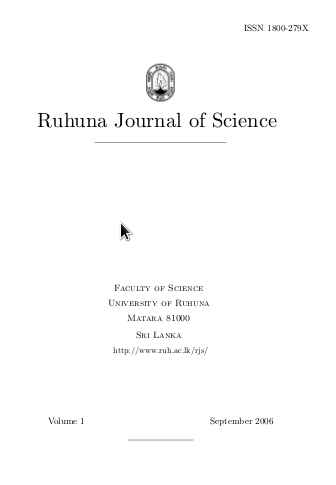Infestation of Ceratothripoides claratris (Shumsher) (Thysanoptera: Thripidae) on selected food crops in Thailand
Abstract
Infestation of Ceratothripoides claratris, the most prevalent thrip pest species on tomatoes in Thailand was studied on eight different food crops, chili, cowpea, cucumber, egg- plant, pumpkin, tomato, water melon and yard-long bean, in an open side-wall plastic house at the campus of Asian Institute of Technology, Thailand. Percentage infested leaves and abundance of C. claratris on leaves of these crop species were determined at two-week intervals in three separate sampling occasions. The findings indicated that C. claratris has a potential to infest all the food crops tested. However, the abundance of thrips per unit leaf area and degree of infestation varied significantly. Two varieties of tomatoes, i.e., King Kong II and Luktho were found to be the most preferable food crop species for C. claratris. The degree of host preference of C. claratris was determined by the crop species, time and their combined effects.References
Gupta PD, Thorsteinson AJ. 1960. Food plant relationships of the diamondback moth [Plutella maculipennis (Curt.)]. II. Sensory regulation of oviposition of the adult female. Entomologia Experimentalis et Applicata. 3: 305-314.
Jangvitaya P. 1993. Studies on the family Thripidae (Insecta: Thysanoptera) from Thailand. M.Sc. thesis, Tokyo University of Agriculture, Tokyo, 254 pp.
Murai T, Kawai S, Chongratanameteekul W, Nakasuji F. 2000. Damage to tomato by Ceratothripoides claratris (Shumsher) (Thysanoptera: Thripidae) in cen- tral Thailand and a note on its parasitoid, Goethena shakespearei Girault (Hymenoptera: Eulophidae). Applied Entomology and Zoology 35: 505-507.
Premachandra WTSD, Borgemeister C, Chabi-Olaye A, Poehling HM. 2004. Influ- ence of temperature on the development, reproduction and longevity of Cera- tothripoides claratris (Thysanoptera: Thripidae) on tomatoes. Bulletin of Ento- mological Research 94: 377-384.
Premachandra WTSD, Borgemeister C, Maiss E, Knierim D, Poehling HM. 2005a. Ceratothripoides claratris, a new vector of a Capsicum chlorosis virus Isolate Infecting Tomato in Thailand. Phytopathology 95: 659-663.
Premachandra WTSD, Borgemeister C, Mamoudou S, Achilles T, Poehling HM. 2005b. Spatio-Temporal Distribution of Ceratothripoides claratris (Thysanoptera: Thripidae) on Tomatoes in Thailand. Environmental Entomology, 34: 883-890.
Rodmui P. 2002. Population dynamics and biological control of thrips, Cera- tothripoides claratris (Shumsher) (Thysanoptera: Thripidae), on tomato under protected cultivation in Thailand. M.Sc. thesis, Kasetsart University, Bangkok, Thailand, 50 pp.
Rosenthal GA, Berenbaum MR. 1991. Herbivores, their interaction with secondary plant metabolites, 2nd edn, vol 1. New York: Academic Press. SAS Institute. 1999. SAS/STAT user’s guide. SAS Institute, Cary, NC.
Downloads
Published
Issue
Section
License
From Volume 7 (2016) onwards, all articles published in Ruhuna Journal of Science are Open Access articles published under the Creative Commons CC BY-NC 4.0 International License. This License permits use, distribution and reproduction in any medium, provided the original work is properly cited and is not used for commercial purposes.
Copyright on any research article published in RJS is retained by the respective author(s).
Authors who publish with this journal agree to the following terms:
a) Authors retain copyright and grant the journal right of first publication with the work simultaneously licensed under a Creative Commons Attribution License CC-BY-NC 4.0 International, that allows others to share the work with an acknowledgement of the work's authorship and initial publication in this journal.
b) Authors are able to enter into separate, additional contractual arrangements for the non-exclusive distribution of the journal's published version of the work (e.g., post it to an institutional repository or publish it in a book), with an acknowledgement of its initial publication in this journal.
c) Authors are permitted and encouraged to post their work online (e.g., in institutional repositories or on their website) prior to and during the submission process, as it can lead to productive exchanges, as well as earlier and greater citation of published work (See The Effect of Open Access).

